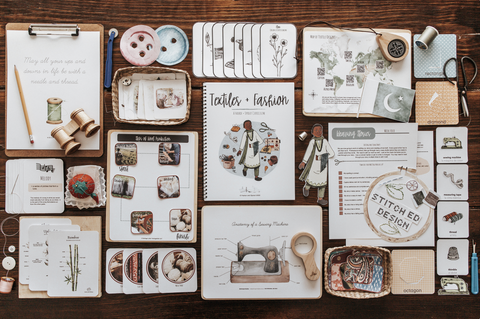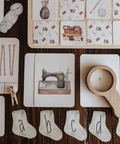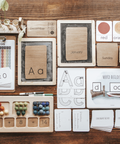Harbor and Sprout
Textiles & Fashion Patchwork Study
$30.00
Title
$30.00
Calling all budding textile artists! Get ready to explore textile design, fabric, natural dyes, patterns, and all things textiles & fashion with the Harbor + Sprout Textiles & Fashion Patchwork Study, the November 2022 release of our original elementary-level homeschool unit study curriculum. This unit study features 4 weeks of lesson plans and materials covering all 9 of our core subjects plus a playful supplemental section of thematic activities. This unit study is meant for use by children ages 3-12.
This unit is delivered via a secure link as a digital download. Shop our corresponding Morning Basket Pack by Rebecca Clarke of Whimsy Printables here!
CONTENT:
Handbook
- Daily, weekly, and monthly planning pages
- Booklist including stories, poems, and field guides with recommended ages, subject correspondence, and brief summaries for each title
- Lesson plans for 4 levels of learning
- Family read-aloud recommendations
- Character kit- new monthly character illustrated by Stephanie Groves to act as your guide through the unit
- Unit Recipe
- Supply List
LESSONS
Science
- Week 1: What Are Synthetic Fibers?: Find out what synthetic fibers are and how they are made. Search for synthetic fibers around your home. Complete an experiment with homemade slime.
- Week 2: Nylon: Study how nylon is made. Discover items that are made of nylon. Learn about the unique properties of nylon. Complete the nylon coloring page. Create a fun craft from recycled nylon stockings.
- Week 3: Polyester: Learn about how polyester is made. Find out about the unique properties of polyester, including some of its pros and cons. Watch the video about polyester is made. Complete the polyester vs. cotton investigation by comparing how polyester and cotton each react to a number of different tests. Color the coloring page.
- Week 4: Microplastics: Find out what microplastics are and where they come from. Watch the video on microplastic pollution. Complete the microplastics and the food chain interactive activity. Write down what you've learned this month about the pros and cons of synthetic fabric.
Nature Study
- Week 1: Cotton: Discover how cotton is grown. Study about where cotton grows best and it looks as a plant. Learn about different cotton harvesting techniques. Find out how cotton is turned into thread and then into a t-shirt. Complete the activity to create your own cotton flower. Go on a cotton scavenger hunt. Challenge yourself to complete the Cotton Blower STEM Challenge.
- Week 2: Bamboo: Study the different stages in the bamboo growth cycle. Discover how bamboo is turned into soft, silky sheets. Learn the best practices for successfully growing bamboo at home and grow your own bamboo. Create beautiful bamboo art. Take your learning one step further by completing the antibacterial experiment.
- Week 3: Wool: Find out where wool comes from. Learn how wool is grown and how it is sheared. Then, find out how that sheared wool is turned into yarn and eventually becomes your favorite, cozy sweater. Create a fuzzy sheep craft. Discover the art of knitting and learn some knitting techniques.
- Week 4: Natural Dyes: Learn about natural dyes and where they come from. Discover the best techniques for how to dye cloth. Use natural sources to create your own dye at home. Create a pounded plant and flower print.
Language Arts
- Week 1: Wonderful Words of Sewing: Learn about the -in word family. Study sewing vocabulary using the included vocabulary list and the "Explore your Vocabulary" worksheet. Practice spelling sewing vocabulary words of your choosing. Explore sewing vocabulary further with the sewing vocabulary cards. Complete the word search and copy work. Select a word and study its etymology. Write a story about a magical sewing box.
- Week 2: The Tale of Tom Kitten: Read or listen to the story of Tom Kitten. Enjoy a fancy tea time with Mrs. Tabitah Twitchit. Learn how to sew on a button. Summarize the story in your own words and answer questions about the story to deepen your understanding. Test your knowledge of the story by putting the sequence cards in order. Fill in the letter "B" with buttons. Practice writing words and phrases from the story.
- Week 3: Regular Verbs & Simple Past: Discover how to make verbs past tense. Watch the adding -ed video. Learn about the rules of regular verbs. Practice what you've learned by completing the Stitch the Verb activity. Complete the Regular Verbs Worksheet. Write a sewing story.
- Week 4: Funny Fill-It-Ins: Learn how to complete funny fill-ins. Complete the funny fill-ins provided and practice your parts of speech along the way. Have fun writing your own funny fill-in!
Writing
- Week 1: Story Writing: Discover the six parts of a story: characters/setting, conflict, rising action, climax, falling action, and resolution. Listen to a fun story. Practice identifying the six parts of a story in your favorite story.
- Week 2: Characters and Conflict: Learn about characters and setting. Discover how to develop a character for your story. Write about your favorite story character, and then develop your own character. Explore how to add conflict to your story. Identify conflict in your favorite story, then create conflict for your own story.
- Week 3: Plan Your Story: Study more about rising action, climax, falling action and resolution. Brainstorm how these story elements can be included in your story based off of the characters and conflict that you chose in week two. Complete a rough draft of your story.
- Week 4: Editing and Final Draft: Edit your story for errors. Use the included checklist as you edit. Learn about descriptive language. Add descriptive language to your story. Write the final draft of your story.
History
- Week 1: Linen: From Field to Fabric: Learn what a textile worker is. Study the history of how textiles how have developed over time. Explore how flax becomes linen. Go on an exciting textiles field trip to learn about different textiles look and feel. Color the flax coloring sheet. Complete a textile report.
- Week 2: Wool: From Fleece to Wool: Study how animal coats can be used to create wool and which animals produce coats that are good for making wool. Learn about the process of creating wool from animal coats. Complete the worksheet about the steps of wool production. Color the Animal Sources of Wool coloring pages. Write a textile report.
- Week 3: Silk: The Queen of Fabric: Discover how a beautiful, luxurious fabric can be created using the cocoons from silkworms. Explore the history of the Silk Road and its significance for trade from Asia to Europe. Color the silkworm. Enjoy playing the silk matching game. Complete the silkworm maze. Compile a textile report.
- Week 4: Textile Production & The Industrial Revolution: SExplore some of the many inventions that made it possible to produce textiles at a faster pace. Discover how textiles were made before the Industrial Revolution and how those processes were changed. Color the coloring pages and complete an invention report.
Geography
- Week 1: The Islamic Republic of Pakistan: Find Pakistan on the world map. Discover some interesting facts about Pakistan including its national flower, national capital, and its textile industry. Learn about the symbolism on the Pakistan flag. Study the trivia cards included.
- Week 2: Maps: Trace the continent of Asia and the country of Pakistan. Identify Pakistan on the world map. Locate the Arabian Sea. Cut out the labels and use them to label the map of Greece. Label the blank map of Pakistan.
- Week 3: Pakistani Culture and Traditions: Learn about the culture of Pakistan. Find out which language is spoken, what kind of food they eat, how their government is structured and more. Learn about Pakistani truck art. Complete the alphabet matching page. Decorate your own truck while drinking some Pakistani Chai Tea.
- Week 4: Textiles Around the World: Explore the many different textiles that are produced all over the world. Scan the QR codes at each location to find out more. Take notes on the notes page to help you remember what you've learned. Complete the World Map Review, if desired.
Music
- Week 1: The Elements of Music: Discover many different musical elements. Learn the meaning of each element. Study the Elements of Music Flashcards to help practice what each element means. Play the Elements of Music Matching Game.
- Week 2: Beatwoven: Study the company Beatwoven, and learn how Nadia-Anne Ricketts creates fabric out of the feelings she feels and images she "sees" when she listens to music. Create your own fabric samples after listening to the three songs provided. Consider how the elements of music influenced your fabric designs.
- Week 3: Musical Texture: Explore some words that describe texture in everyday objects. Then, explore terms that describe texture in music. Study the meaning of each word and then complete the worksheet.
- Week 4: The Alghoza: Discover what an Alghoza flute is, where it comes from, and how it is played. Make your own flute from cardstock.
Art
- Week 1: Natural Fibers and Dyes: Study the artist spotlight on Amanda Cobbett and her fascinating nature-inspired creations. Draw your favorite mushroom. Think about how you would create your own textile mushroom. Create a felted mushroom. Learn how linen and natural cordage are made. Create a natural cordage weaving. Experiment with natural dye plants and create a natural tie dye project. Learn about dyeing eggs with natural dyes.
- Week 2: Yarn: Explore artwork done by Judith Scott. Enjoy a yarn printing art project. Create string art. Discover how to create a Judith Scott-inspired yarn and clay sculpture. Make your own trollen wheel and use it to weave a seven strand rope. Use yarn to make your own yarn painting. Create a yarn bowl.
- Week 3: Metallics: Study the artist Gustav Klimt and his gold leaf artwork. Create your own artwork imitating the Golden Woman by Anne-Marie Zilberman. Discover another use of gold in artwork by creating a Klimt inspired project. Read the book Klimt and His Cat. Enjoy fabric stamping with gold paint. Study the history of textile printing. Create a quilted house and design a quilt of your own.
- Week 4: Embroidery: Learn about the fascinating artwork created by Victoria Villasana. Create a Villasana-inspired self portrait. Learn about some basic embroidery stitches. Make your own embroidered pillow. Use paper to create your own paper woven portrait. Discover how to draw woven fabric. Explore the art of leaf embroidery. Decorate paper leaves to look embroidered.
Math
- Week 1: Fabric Math Puzzles: Complete the math learning puzzles that best match the learner's math level.
- Week 2: Measurements and Area Calculation: Practice measuring the length and height of a rectangle. Discover how to calculate area. Measure the length and height of the included rectangles and calculate their area.
- Week 3: Shape Matching: Match the shape with the corresponding cut out. Practice the names of each shape.
- Week 4: Shape by Pattern: Practice sorting shapes based on attributes and patterns.
Supplement
Nature Activities
- Textiles Coloring Sheets
- Sewing Poster
- Words to Build
- Math Cards
- Textiles Flash Cards
- Memory Disks
- Anatomy of a Sewing Machine
- Compound Word Write and Match
Wellness & Quiet Time
- Textiles 3 Part Cards (Spanish)
- Textiles & Fashion Dot Painting
- Textiles Mindfulness Coloring
- Textile Paper Dolls
Don't Forget These:




































